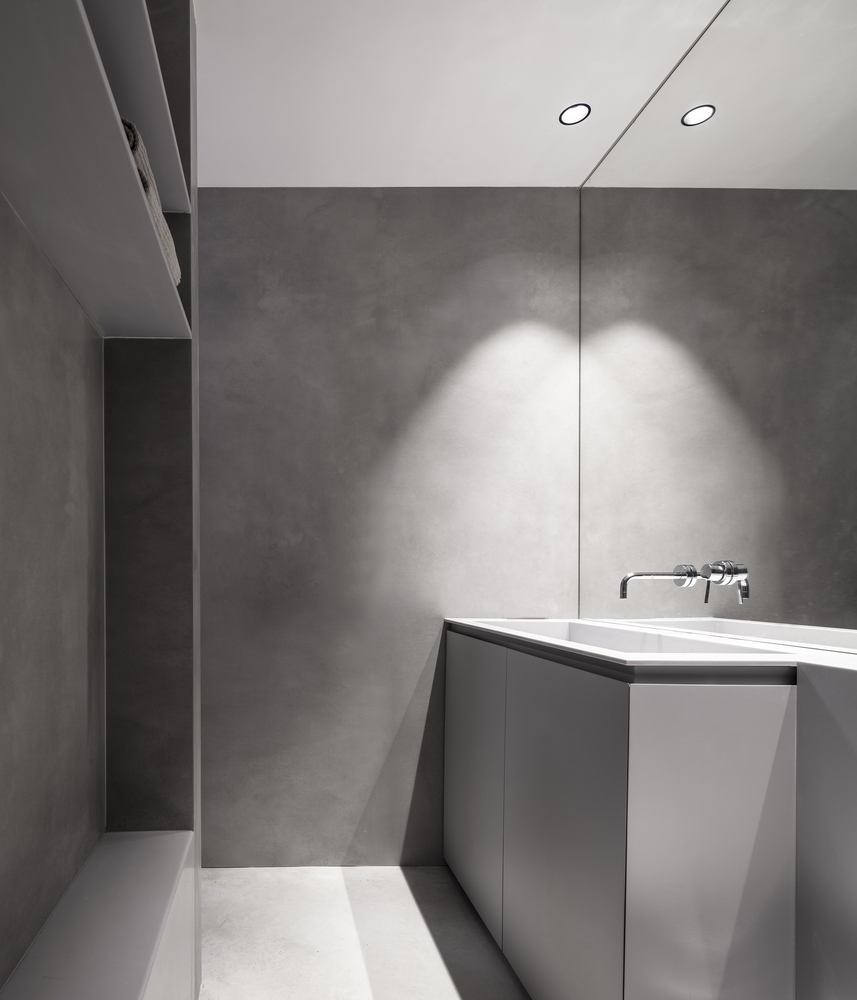House in Vilamoura Pedro Rogado + Vasco Mendia
2011-07-27 01:00
架构师提供的文本描述。这片土地东临高尔夫球场,南临一座独栋独立住宅,西临维拉穆拉一号高尔夫球场,最后北临一小块公共绿地。该遗址的特点是西北向的地势下降,西面与高尔夫球场的视觉联系,北向的山地地平线,树木-松林的强烈存在和形态,以及城市和周边地区景观的特殊性。
Text description provided by the architects. The lot is faced East by a golf course road, South by a lot where a single-family detached house is built, West by the golf course number 1 of Vilamoura, and finally North by a small public green space. Features of this site are the descending topography on the North-West direction, the visual relationship with the golf course to the West and the mountainous horizon towards North, the strong presence and morphology of trees - pine forest - and finally the specificity of urban and landscape surrounding territory.
北-西北斜坡,高尔夫球场向西,山向北,阻碍了一个良好的南方方向。通过这种方式,建立了四个轴,现有的松树叠加在上面。后者部署在地块的南部,那里的坡度更突出,而北半球的坡度更软,树木不存在。在地形的顶部,土地的间隙出现了,在树林中的小空地,在高高的树冠中间。这些缺口的高度测量允许与高尔夫球场和北方的山地地平线建立视觉关系。
The North-northwestern slope, the view of the golf course towards West and the hills to the North deter a favorable orientation towards South. In this way four axes are created upon which the existing pine trees superimpose. The latter deploy in the southern half of the plot where the slope is more accentuated, in contrast to the northern half where the slope is softer and trees inexistent. On that top part of the terrain interstitial spaces of land appear, small clearings in the woods, among the high canopies of the trees. The altimetry of these gaps allows a visual relationship with the golf course and the mountainous horizon to the North.
© Fernando Guerra | FG+SG
有两种类型的景观标志着周围地区的地形:北面的石灰岩阿尔加韦,以及南部的阿尔加韦海岸地区。我们保留石灰石阿尔加韦崎岖的地貌和人类的祖先工作,通过建造石墙来控制景观,以征服崎岖的地形。阿尔加韦沿海地区是实施维拉穆拉城市规划的地方,其特点是沙质的小坡地,松林生长在此。
Two types of landscape mark the topography of the surrounding territory: the Limestone Algarve on the North towards the mountains and the Algarve coast area on the South. We retain the rugged physiognomy of the Limestone Algarve and the ancestral work of man to dominate the landscape by building walls of stone to subdue the rough terrain – socalcos. The Algarve coast area, where the urban plan of Vilamoura is implemented, is characterized by sandy slightly sloping land, on which groves of pine trees developed.
© Fernando Guerra | FG+SG
维拉穆拉的城市规划具有现代运动的几个特点。在中心,宽阔的公共空间和高楼大厦-“现代范式”的矩阵-我们可以看到使用这种语言的建筑。围绕中心,其他较低高度的项目发展这种建筑。再往北,围绕着高尔夫球场和松树,展现了另一个现代主义冒险的典型形态-花园城。
The Urban Plan of Vilamoura features a few characteristics of the Modern Movement. In the center, with wide public spaces and high buildings – matrix of the “Modern paradigm” – we can see constructions that use that language. Surrounding the center, other projects of lower height develop this kind of architecture. Further North, surrounding the golf courses and among the pine trees, unfolds another typical morphology of the modernist adventure– The Garden City.
这座550平方米的单户独立住宅的项目安排如下:两间主卧室,配有私人浴室,两层楼的图书馆通过天窗照亮,上面的松树、树冠和天空,还有另外两间卧室,共用一间浴室和一间小客厅,勾勒出这座房子的私人核心。一个前厅和一个厨房,通过露台与餐厅和主客厅相连,构成了公共部分。在地下,组织了交通、服务和配套区域。在室外,室内是延伸到露台和露台的手工瓷砖,和一个游泳池,其芭蕾和技术空间放在地下。
The program for this 550 sqm, single-family detached house is organized as follows: two master bedrooms with private bathrooms coupled to a two stories library illuminated through a zenithal glass skylight framing the pines canopies and the sky above and two other bedrooms that share a bathroom and a small living room outline the private core of the house. A vestibule and a kitchen articulated with the dinning and main living room through a patio composes the public part. Under the ground, the circulations, services, and supporting areas are organized. On the outside, the interior is extended through terraces and patios of handmade tiles, and a swimming pool whose balneary and technical space are placed underground.
© Fernando Guerra | FG+SG
整合和功能约束形成了植入。该计划分为三个独立的空间-公共区域、主卧室和次级卧室,填补现有的空白(空地),以便与现有的树木建立对话。为了尊重地形的自然坡度,这些体积被放置在不同的高度,允许与周围景观的视觉关系,并从南方捕捉太阳光。
Integration and functional constraints forged the implantation. The program is divided in three independent volumes – public area, master bedrooms, and secondary bedrooms, filling the existing gaps (clearings) in order to establish a dialogue with the pre existing trees. The volumes are positioned at different heights in order to respect the natural slope of the terrain, allowing visual relationships with the surrounding landscape and catching solar light from the South.
© Fernando Guerra | FG+SG
这三个独立卷之间的连接是地下开发的,以及游戏室、服务室、看管区、支助和访客浴室、储藏室、技术空间和洗衣房。这些区域通过各种天窗照明,露台深入地下,窗户通向小梯田。从周边地区的地形来看,除了上述与地形的关系外,还强调了对山脚的更抽象的参考。山脚是传统的农业土壤平台,由石墙建造,以保留待定的土地。因此,建筑体积通过三面钢筋混凝土挡土墙与地形相连,标志和揭示了地形的特殊性。
The connections between these three independent volumes are developed underground as well as the playroom, the service room, the caretakers area, the support and visitors bathroom, the storage room, the technical space and the laundry. These areas are illuminated through various zenithal skylights, patios dug deep into the ground and windows leading to small terraces. From the topography of the surrounding territory, in addition to the above-mentioned relationships with the terrain, a more abstract reference to the socalcos is emphasized. The socalcos are traditional platforms of agricultural soil built of stone walls to retain the pending land. Thus the built volumes articulate with the terrain through three retaining walls of reinforced concrete which mark and reveal the topographic specificity.
© Fernando Guerra | FG+SG
这些墙中的每一个都与水平板相关联,从而定义了适宜居住的空间。垂直墙和水平板通过一个水平狭缝连接在南侧,以捕捉夏季春分和冬季春分之间的太阳照度。这些楼板延伸到悬挑处,以创造内部和外部的连续性和连接,并提供对太阳辐射和降雨的保护。横向覆盖使两个更南的区块能够从向西和向北的视野中受益。其他混凝土墙的外部设计是为了控制地形和创造不同类型的外部空间。其结果是一种与“批判性区域主义”密切相关的当代语言,它将特定的传统和现代主义特征结合在一起,在情节本身的特征、比拉穆拉的城市语言和周围的景观之间形成了一种张力。
Each of these walls is associated with a horizontal slab, thus defining the habitable spaces. The vertical walls and horizontal slabs articulate at the South side through a horizontal slit calculated to capture the solar illumination between the Summer Equinox and the Winter Equinox. The slabs extend in overhang to create continuity and a link between the interior and the exterior, and to provide protection against solar radiation and rainfall. The horizontal coverage allows the two further south blocks to benefit from the view towards West and North. Outside other concrete walls are designed to control the terrain and create different types of exterior spaces. The result is a contemporary language closely connected to “critical regionalism”, in which specific traditional and modernistic features are brought together, creating a tension between the characteristics of the plot itself, the urban language of Vilamoura and the surrounding landscape.
 举报
举报
别默默的看了,快登录帮我评论一下吧!:)
注册
登录
更多评论
相关文章
-

描边风设计中,最容易犯的8种问题分析
2018年走过了四分之一,LOGO设计趋势也清晰了LOGO设计
-

描边风设计中,最容易犯的8种问题分析
2018年走过了四分之一,LOGO设计趋势也清晰了LOGO设计
-

描边风设计中,最容易犯的8种问题分析
2018年走过了四分之一,LOGO设计趋势也清晰了LOGO设计




































































































































